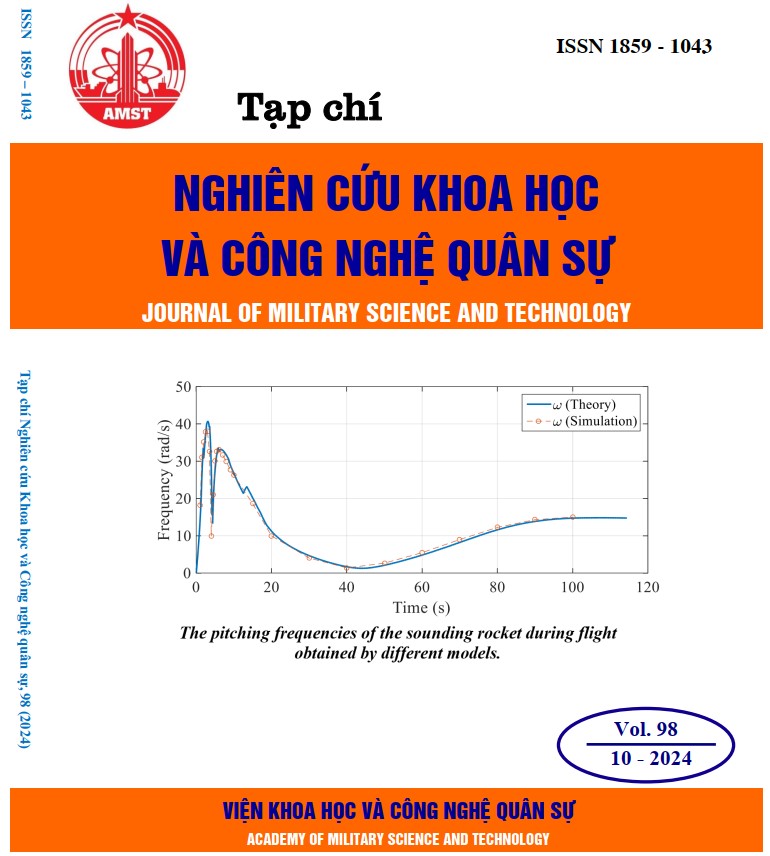Synthesis of optimal power tracking Pitch angle controller for wind turbines based on Fuzzy Logic System and Dynamic Surface Control
342 viewsDOI:
https://doi.org/10.54939/1859-1043.j.mst.98.2024.50-60Keywords:
Wind Turbin; Pitch Angle; Dynamic Surface Control; Fuzzy Logic system; Optimal Power Point.Abstract
This paper proposes a method to enhance the performance of Wind Turbin by a Fuzzy logic system. The fussy logic system is carried out as an intelligent system in order to determine a desired Pitch angle for each value of wind speech such that the Turbin’s power is maximum. To ensure that the pitch angle can track stably the desired angle, Dynamic surface Control is developed. The control quality of closed-loop system is analysed and simulated with different scenarios.
References
[1]. Đinh Mạnh Cường, Mai Thị Trinh, “Nghiên cứu một số điều kiện phát triển điện gió tại Việt Nam trên cơ sở dự án Nhà máy Phong Điện I – Bình Thuận”, Trường Đại học Khoa học Tự Nhiên, ĐHQGHN, (2016).
[2]. Minh Hà Dương, Ngô Thị Tố Nhiên, “Các kịch bản phát triển điện gió ở VIệt Nam đến năm 2030”, Sáng kiến chuyển dịch Năng lượng Việt Nam (VIET SE), (2019).
[3]. El-Ahmar, M. H., Abou-Hashema M. El-Sayed, and A. M. Hemeida. "Evaluation of factors affecting wind turbine output power." 2017 Nineteenth International Middle East Power Systems Conference (MEPCON). IEEE, (2017). DOI: https://doi.org/10.1109/MEPCON.2017.8301377
[4]. Hayatdavudi, Mahdi, Mojtaba Saeedimoghadam, and Seyed MH Nabavi. "Adaptive control of pitch angle of wind turbine using a novel strategy for management of mechanical energy generated by turbine in different wind velocities." Journal of Electrical Engineering and Technology 8.4: tr. 863-871, (2013). DOI: https://doi.org/10.5370/JEET.2013.8.4.863
[5]. Hosseini, Ehsan, and Ghazanfar Shahgholian. "Different types of pitch angle control strategies used in wind turbine system applications." Journal of Renewable Energy and Environment 4.1 (2017).
[6]. Nhat-Minh Le Phan, Tung Thanh Nguyen, Duong Tung Nguyen, Nga Thi-Thuy Vu, “Output Feedback Adaptive Pitch Angle Control for Variable Speed Wind Turbine”, JST: Smart Systems and Devices, Volume 33, Issue 3, 057-064, (2023). DOI: https://doi.org/10.51316/jst.168.ssad.2023.33.3.8
[7]. Apata, O., and D. T. O. Oyedokun. "An overview of control techniques for wind turbine systems." Scientific African 10: e00566, (2020). DOI: https://doi.org/10.1016/j.sciaf.2020.e00566
[8]. Chih-Ming Hong, Cong-Hui Huang, Fu-Sheng Cheng, “Sliding Mode Control for Variable-speed Wind Turbine Generation Systems Using Artificial Neural Network”, Volume 61, Pages 1626-1629, (2014). DOI: https://doi.org/10.1016/j.egypro.2014.12.310
[9]. Farah Echiheb, Yasmine Ihedrane, Badre Bossoufi, Manale Bouderbala, Saad Motahhir, Mehedi Masud, Sultan Aljahdali & Madiha ElGhamrasni, “Robust sliding-Backstepping mode control of a wind system based on the DFIG generator”, Scientific Reports volume 12, Article number: 11782 (2022). DOI: https://doi.org/10.1038/s41598-022-15960-7
[10]. Haijun Ren, Hao Zhang, Guang Deng and Bin Hou, “Feedforward Feedback Pitch Control for Wind Turbine Based on Feedback Linearization with Sliding Mode and Fuzzy PID Algorithm”, Volume 2018 | Article ID 4606780, (2018). DOI: https://doi.org/10.1155/2018/4606780
[11]. L. Colombo, M.L. Corradini, G. Ippoliti, G. Orlando, “Pitch angle control of a wind turbine operatingoperating above the rated wind speed: A sliding mode control approach”, Volume 96, Pages 95-102, (2020). DOI: https://doi.org/10.1016/j.isatra.2019.07.002
[12]. Paladugu Venkaiah, Bikash Kumar Sarkar, Amitava Chaterjee, View all authors and affiliations, “Pitch control of electrohydraulic semi-rotary-actuated wind turbine with actuator and valve fault using generalized power-based exponential rate reaching law sliding mode controller”, First published online February 17, 2023. Volume 237, Issue 8, (2023). DOI: https://doi.org/10.1177/09596518231154632
[13]. Wang Xin, Zhu Wanli, Qin Bin, Li Pengcheng, “Sliding mode control of pitch angle for direct driven PM Wind turbine”, (2014). DOI: 10.1109/CCDC.2014.6852584. DOI: https://doi.org/10.1109/CCDC.2014.6852584
[14]. Kim, Duyen Ha Thi, et al. "Adaptive control for uncertain model of omni-directional mobile robot based on radial basis function neural network." International Journal of Control, Automation and Systems 19.4: tr. 1715-1727, (2021). DOI: https://doi.org/10.1007/s12555-019-1004-6
[15]. J.C.Das. Power system harmonics and passive filter design. IEEE Press Series on Power Engineering, IEEE Press and Wiley, (2015). DOI: https://doi.org/10.1002/9781118887059
[16]. Nguyễn Doãn Phước, Phân tích và điều khiển hệ phi tuyến, NXB Bách Khoa, (2021).
[17]. H. Ren, G. Deng, B. Hou, S. Wang, and G. Zhou, “Finite-Time Command Filtered Backstepping Algorithm-Based Pitch Angle Tracking Control for Wind Turbine Hydraulic Pitch Systems”, IEEE Access, vol. 7, pp. 135514–135524, (2019). DOI: https://doi.org/10.1109/ACCESS.2019.2941891
[18]. Slah, Hafsi, Dhaoui Mehdi, and Sbita Lassaad. "Advanced control of a PMSG wind turbine." International Journal of Modern Nonlinear Theory and Application 5.1: 1-10, (2016). DOI: https://doi.org/10.4236/ijmnta.2016.51001
[19]. M. R. Patel and O. Beik, “Wind and solar power systems: design, analysis, and operation”, CRC press, (2021). DOI: https://doi.org/10.1201/9781003042952
[20]. Hamoodi, Safwan A., Farah I. Hameed, and Ali N. Hamoodi. "Pitch angle control of wind turbine using adaptive fuzzy-PID controller." EAI Endorsed Transactions on Energy Web 7.28 (2020).







